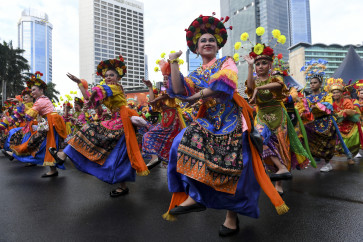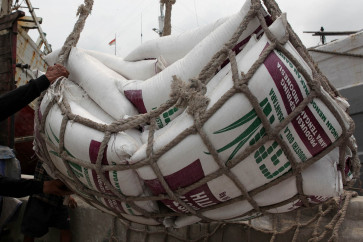Popular Reads
Top Results
Can't find what you're looking for?
View all search resultsPopular Reads
Top Results
Can't find what you're looking for?
View all search resultsWomen artisans, and artists, at work
Designer Edward Hutabarat says a love for batik is not expressed through buying new items each month to put in one’s closet
Change text size
Gift Premium Articles
to Anyone
D
esigner Edward Hutabarat says a love for batik is not expressed through buying new items each month to put in one’s closet. True love, after all, comes from an understanding that goes beyond superficial attractions – for batik, that means also wanting to know more about the women artists and artisans behind the scenes, he believes.
“A true love for batik means you see the item as the symbol of female empowerment,” he said.
He said traditionally men were not involved in the art of hand-made batik, and he is continually impressed by the diligence of women who must work eight hours in a row in often unfavorable workshop conditions.
“They work in a hot room accompanied only by a radio playing a traditional puppet show and soaps. And after work, these women go home on foot and still take care of their children and husbands. Amazingly, their children are not malnourished,” said Edward, recalling his experiences from observing workers at factories in major batik producing centers such as Cirebon, Pekalongan and Yogyakarta.
In his opinion, the batik work is a symbol of the power of Indonesian women as supreme multi-taskers: faced with limited facilities and many responsibilities at work and the home, they are still able to produce beautiful pieces of batik.
He said he felt an affinity with the women who continue the traditions of their ancestors.
“Staying with them is where I belong. I sit, eat and drink with them. At the same time, I look for materials for my newest collection,” he added.
The love of batik does connects people across nations. In the 19th century, Dutch and Eurasian woman produced their own distict motifs, now highly prized collector’s items.
Another woman with a passion for batik was Ann Dunham, who conducted research on micro-financing in rural villages in Central Java, also felt a strong bond with the women workers of Central Java. Her collection has become celebrated since the election of her son, Barack Obama, to the US presidency.
“She wanted to celebrate her love of Indonesia and women,” Obama’s half-sister, Maya Soetoro-Ng, was quoted by media as saying when she opened the exhibition, Ann Dunham’s Legacy: A Collection of Indonesian Batiks, in Kuala Lumpur earlier this year.
“She wanted to build a home, a place to hang her batik on the walls and over the furniture. She died before she could create this palace of memories of wood, fabrics and tapestry.”
President Obama also sent a video message acknowledging his mother’s respect for the women of Indonesia.
“As a woman, she knew the textiles meant a livelihood for the mothers and young women who made them. As an anthropologist, batik helped her to understand the lives of others -- their culture, traditions, challenges and hopes,” he said of his mother, who died of cancer in 1995.
“In these fabrics, I’m reminded of the principles that animated my mother’s life. She understood that whether you live in a rural village or a teeming city, we all share certain basic aspirations to live in dignity, peace and security; to provide for our families; to give our children a better life.
Soetoro-Ng’s comment concerning her mother’s belief in the power of art to bring people together is fitting for the influence of batik.
“Art is not superficial, but something deep. It resonates with power, identity and history,” she told media.
– Frederica Ermita Indriani
The small print
• While Ronald Reagan and Bill Clinton are US presidents who wore batik during
trips to Indonesia, Barack Obama, who lived part of his childhood in Jakarta, has a much closer connection to the fabric; his mother, Ann Dunham, who lived many years in Indonesia, especially in Central Java, was a collector.
•It may be a surprise to some that the oldest extant batik prints do not date from the Indonesian archipelago, writes Michael Hitchcock in Indonesian Textiles (Periplus, 1991). That honor actually belongs to prints found in Egypt which date to the 5 and 6 centuries AD. However, the British scholar acknowledged that fabrics and textiles do not survive well in Java’s humid tropical climate. “Hence while little is known about the early history of batik in the archipelago, what is clear is that Indonesian, especially Javanese, tools and methods have been admired and copied by dyers throughout the world,” he states.
• The interest in Javanese batiks soared in the 19th century among scholars and also traders, with major western museums obtaining them for their collections. Indonesian batik designer Iwan Tirta marveled at the British Museum collection’s of batiks from Sir Stamford Raffles, but it could have been even more spectacular, Hitchock says. “The full extent of his collecting endeavors will never be fully appreciated since fire broke out on the ship on which Raffles was returning to Britain and much was destroyed.”
• The first batik factory in the Netherlands was established in Leiden in 1835; Indonesian batik makers were brought to the Netherlands to teach Dutch workers, Hitchcock says. In the following decade, Swiss firms also produced imitation batiks but the adopting of the more time-efficient wax-block printing method in Java in the 1870s over painstaking hand-drawn batik led to production declining in those nations.
• Traditionally, wax used for applying the motifs to the fabric by Javanese batik makers was beeswax imported from Sumatra, Sumbawa and Timor, Hitchcock said. By the late 19th century, ozokerite from Europe was used, and today beeswax mixed with paraffin, adhesives and animal fats are common. “Recipes for batik wax are often closely guarded secrets,” he wrote.
• In waxing on about wax, in his 2009 work Batik: Sebuah Lakon (Batik: A Tale, 2009), the late Iwan Tirta noted that it was not only the “usual suspects” of batik designers, batik company owners, industry associations and the public who must be involved in the textile’s preservation and advancement, but also such a seemingly unlikely party as timber companies. Iwan said that the best beeswax came from the wild honeybees which nested in “Kempas” trees (Kompassia), often felled in timber projects. He also lamented the scarcity of natural dyes due to the same irresponsible environmental practices.










